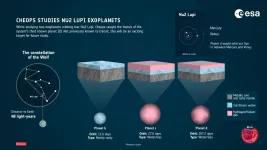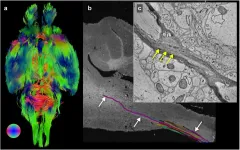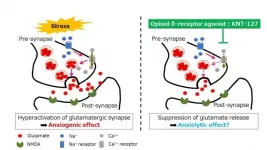(Press-News.org) While exploring two exoplanets in a bright nearby star system, ESA's exoplanet-hunting Cheops satellite has unexpectedly spotted the system's third known planet crossing the face of the star. This transit reveals exciting details about a rare planet "with no known equivalent", say the researchers.
The discovery is one of the first results from ESA's Cheops (CHaracterising ExOPlanet Satellite), and the first time an exoplanet with a period of over 100 days has been spotted transiting a star that is bright enough to be visible to the naked eye.
Named Nu2 Lupi, this bright, Sun-like star is located just under 50 light-years away from Earth in the constellation of Lupus (the Wolf). In 2019, the High Accuracy Radial velocity Planet Searcher (HARPS) at the ESO 3.6-metre telescope in Chile discovered three exoplanets (named 'b', 'c' and 'd', with the star deemed to be object 'A') in the system, with masses between those of Earth and Neptune and orbits lasting 11.6, 27.6 and 107.6 days. The innermost two of these planets - b and c - were subsequently found to transit Nu2 Lupi by NASA's Transiting Exoplanet Survey Satellite (TESS), making it one of only three naked-eye stars known to host multiple transiting planets.
"Transiting systems such as Nu2 Lupi are of paramount importance in our understanding of how planets form and evolve, as we can compare several planets around the same bright star in detail," says Laetitia Delrez of the University of Liège, Belgium, and lead author of the new finding.
"We set out to build on previous studies of Nu2 Lupi and observe planets b and c crossing the face of Nu2 Lupi with Cheops, but during a transit of planet c we spotted something amazing: an unexpected transit by planet 'd', which lies further out in the system."
Planetary transits create a valuable opportunity to study a planet's atmosphere, orbit, size and interior. A transiting planet blocks a tiny but detectable proportion of its star's light as it crosses in front of its star - and it was this drop in light that led Laetitia and colleagues to their discovery. As long-period exoplanets orbit so far from their stars, the chances of seeing one during a transit are incredibly low, making Cheops' finding a real surprise.
Using the high-precision capabilities of Cheops, planet d was found to be about 2.5 times the radius of Earth, confirmed to take just over 107 days to loop once around its star and, using archival observations from ground-based telescopes, found to have a mass of 8.8 times that of Earth.
"The amount of stellar radiation reaching planet d is also mild in comparison to many other discovered exoplanets; in our Solar System, Nu2 Lupi d would orbit between Mercury and Venus," adds co-author David Ehrenreich of the University of Geneva, Switzerland. "Combined with its bright parent star, long orbital period, and suitability for follow-up characterisation, this makes planet d hugely exciting - it is an exceptional object with no known equivalent, and sure to be a golden target for future study."
Most long-period transiting exoplanets discovered to date have been found around stars that are too faint to allow detailed follow-up observations, meaning that little is known about their planets' properties. Nu2 Lupi, however, is bright enough to be an attractive target for other powerful telescopes based in space -- such as the NASA/ESA Hubble Space Telescope or forthcoming NASA/ESA/CSA James Webb Space Telescope -- or large observatories on the ground.
"Given its overall properties and orbit, this makes planet d a uniquely favourable target for studying an exoplanet with a mild-temperature atmosphere around a star similar to the Sun," says Laetitia.
By combining new Cheops data with archival data from other observatories, the researchers were able to accurately determine the mean densities of all of Nu2 Lupi's known planets, and put strong constraints on their possible compositions.
They found planet b to be mainly rocky, while planets c and d appear to contain large amounts of water enshrouded in envelopes of hydrogen and helium gases. In fact, planets c and d contain far more water than Earth: a quarter of each planet's mass is made up of water, compared to less than 0.1% for Earth. This water, however, is not liquid, instead taking the form of high-pressure ice or high-temperature steam.
"While none of these planets would be habitable, their diversity makes the system even more exciting, and a great future prospect for testing how these bodies form and change over time," says ESA Cheops project scientist Kate Isaak. "There is also the potential to search for rings or moons in the Nu2 Lupi system, as the exquisite precision and stability of Cheops could allow detection of bodies down to roughly the size of Mars. "
Cheops is designed to collect ultra-high precision data of individual stars known to host planets, rather than sweeping more generally for possible exoplanets around many stars - and this focus and precision is proving exceptionally useful in understanding the star systems around us.
"These exciting results demonstrate once again the huge potential of Cheops," adds Kate. "Cheops will allow us not just to better understand known exoplanets, as shown in this and other early results from the mission, but also to discover new ones and reveal their secrets."
INFORMATION:
PITTSBURGH, June 28, 2021 - It was a nagging mystery: A rare-disease expert at UPMC Children's Hospital of Pittsburgh had found a successful treatment for two of the deadliest symptoms of one of the more common classes of rare diseases diagnosed by newborn screenings, but one symptom--painful episodes of muscle breakdown that land victims in intensive care--persisted.
Today, the scientists announce in the journal Clinical & Translational Immunology that they've gotten to the bottom of the self-destructive syndrome and have a good lead on a treatment.
"These episodes looked a lot like inflammatory ...
An incredibly rare hybrid warbler with mismatched color patterns has allowed researchers to disentangle the genetic drivers of two traits that usually come as a package deal--the black face mask and the black throat patch in blue-winged and golden-winged warblers. A new study describing the peculiar bird and pinpointing the location in the genome that controls the face mask and throat patch appears online in the journal Ecology.
"Golden-winged warblers have both a black face mask and a black throat patch, while blue-winged warblers have neither," said Marcella Baiz, postdoctoral researcher at Penn State and first ...
Some exoplanet searches could be missing nearly half of the Earth-sized planets around other stars. New findings from a team using the international Gemini Observatory and the WIYN 3.5-meter Telescope at Kitt Peak National Observatory suggest that Earth-sized worlds could be lurking undiscovered in binary star systems, hidden in the glare of their parent stars. As roughly half of all stars are in binary systems, this means that astronomers could be missing many Earth-sized worlds.
Earth-sized planets may be much more common than previously realized. Astronomers working at NASA Ames Research Center have used the twin telescopes of the international Gemini Observatory, a Program of NSF's NOIRLab, to determine that many planet-hosting ...
WASHINGTON, D.C.--A new study in Annals of Emergency Medicine highlights the importance of protecting physician residents--early-career doctors still in training--and emergency care teams from incidents of physical or verbal abuse.
The survey of 123 physicians, residents, and staff in one emergency department found that 78 percent of all health care workers experienced a violent assault in the prior 12 months, including more than one in five (22 percent) emergency physician residents. Eighty-nine percent of residents experienced verbal assault by a patient in the prior 12 months, compared to 80 percent of other health care workers.
"Violent ...
Philadelphia, June 28, 2021--Researchers at Children's Hospital of Philadelphia (CHOP) have discovered that a specific type of lung cell exhibits unconventional immune properties and may contribute to the outcome of respiratory viral infections. The researchers focused on type II alveolar (AT2) cells, which are non-immune cells of the lung that are critical for basic lung health and tissue repair after lung injury. They found that AT2 cells express high levels of major histocompatibility complex II (MHC-II), an important immune system trigger, and that AT2 MHC-II expression appears to confer an appreciable ...
Researchers at the University of Chicago and the U.S. Department of Energy's (DOE) Argonne National Laboratory have leveraged existing advanced X-ray microscopy techniques to bridge the gap between MRI (magnetic resonance imaging) and electron microscopy imaging, providing a viable pipeline for multiscale whole brain imaging within the same brain. The proof-of-concept demonstration involved imaging an entire mouse brain across five orders of magnitude of resolution, a step which researchers say will better connect existing imaging approaches and uncover new details about the structure of the brain.
The advance, which was published on June 9 in NeuroImage, will allow ...
As social media and other online networking sites have grown in usage, so too has trolling - an internet practice in which users intentionally seek to draw others into pointless and, at times, uncivil conversations.
New research from Brigham Young University recently published in the journal of Social Media and Society sheds light on the motives and personality characteristics of internet trolls.
Through an online survey completed by over 400 Reddit users, the study found that individuals with dark triad personality traits (narcissism, Machiavellianism, psychopathy) combined with schadenfreude - a German word meaning that one derives pleasure from another's misfortune - were more likely to demonstrate trolling behaviors.
"People who exhibit ...
A discovery by a team of researchers, led by a Geisinger professor, could yield a potential new treatment for breast cancer.
In a study published this month in Cell Reports, the team used small molecules known as peptides to disrupt a complex of two proteins, RBM39 and MLL1, that is found in breast cancer cells but not in normal cells.
The research team discovered that the abnormal interaction between RBM39 and MLL1 is required for breast cancer cells to multiply and survive. The team developed non-toxic peptides that prevent these proteins from interacting in breast cancer cells, disrupting their growth and survival.
"Because these proteins do not interact in normal ...
Anxiety, commonly termed as a feeling of fear, dread, and restlessness, is a perfectly normal reaction to stressful situations. However, a state of heightened anxiety, which is the reality for thousands of people who struggle to cope with these feelings, is called anxiety disorder. Anxiety disorder can invoke debilitating fear or apprehension, even without any immediate threat. Though intensive research over the years has yielded a plethora of information, and effective drugs like selective serotonin reuptake inhibitors have been used to alleviate this condition, a lot remains to be understood about this complex condition and ...
The first two COVID-19 vaccines authorized for emergency use by the Food and Drug Administration (FDA) employed a technology that had never before been used in FDA-approved vaccines. Both vaccines performed well in clinical trials, and both have been widely credited with reducing disease, but concerns remain over how long immunity induced by the new vaccine technology will last.
Now, a study from researchers at Washington University School of Medicine in St. Louis, published June 28 in the journal Nature, has found evidence that the immune response to such vaccines is both strong and potentially long-lasting. Nearly four months after the first dose, people who received the Pfizer vaccine still had so-called germinal centers in their lymph nodes churning out ...



